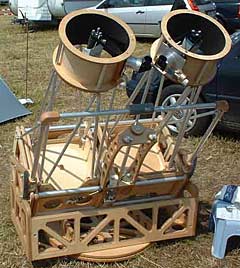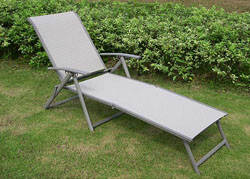
This hand-crafted 250-mm binocular telescope delivers magnificent views of deep-sky objects, but it's not the kind of thing that you grab for a 5-minute observing session.
Helge Schlinzig
All optical instruments are compromises, but that's especially true of binoculars. Most stargazers that I know own at least one set of binoculars, and many use them frequently. Asked what they like most about this class of instruments, most people would answer: simplicity, portability, convenience, low cost, and (above all) bright wide-field views. That's certainly how I feel, anyway.
The flip side is that binoculars have much more limited capabilities than normal astronomical telescopes. (I'm talking now about regular binoculars with fixed magnifications, not specialized binocular telescopes like the one at right that can handle interchangeable eyepieces.) Their modest apertures (front lenses) restrict their ability to show faint objects like galaxies, and their very low magnifications cripple them even more severely for lunar and planetary observing. I'd far rather observe Jupiter with a wobbly $100 60-mm refractor than with any conventional binoculars.
There are two ways to deal with limitations: you can learn to work with them or fight against them. In the case of binoculars, fighting takes the form of bigger apertures and higher magnifications. But big apertures reduce portability, convenience, and low cost. And high magnifications hurt even more, because they conflict with wide-field views, the one arena in which binoculars reign supreme.

At 10X there's still a strong connection to what you see without optical aid; Orion's belt is still recognizable. At 100X, every bright star is an island universe.
Tony Flanders
One great dividing point comes when the binoculars really need to be mounted on a tripod or equivalent support. There are three reasons this may be necessary: to hold the binoculars steady, to support their weight, and (least obviously) to help in aiming them. Most people find it pretty easy to aim 10X binoculars — just look at the place in the sky you're interested in, put the binos in front of your eyes, and you're there. If you need to put the binoculars down to consult a star chart; you can re-aim them as quickly and easily as you did the first time.
This is significantly harder with 15X binoculars. First of all, the margin of error is reduced because the field of view is smaller. But equally important, at 10X I still have an instinctive connection with the view through my unaided eyes. At 15X, the correspondence between what I see with and without the instrument is getting mighty tenuous.
Anybody who's looked through a telescope at 100X will know exactly what I mean. Familiar star patterns are completely lost. Things that are invisible to the unaided eye fill the entire eyepiece. It's an entirely different reality, as though you'd been picked up by a tornado and carried to Oz. Even if advanced image-stabilization technology made it possible to get a steady view through a hand-held telescope at 100X, you'd still need a mount just to keep the scope pointed in one direction while you figured out where you wanted to point it next.
As it happens, I can hand-hold 15x70 binoculars pretty comfortably when I'm firmly planted in a lounge chair with armrests. That's by far my favorite position both for viewing with my unaided eyes and for extended binocular sessions. I can peek directly overhead just by craning my neck, but that posture gets painful in a hurry. Even worse, it means that I can't see things in their proper context, because it's physically impossible to look much beyond the zenith from a standing posture. Far better to relax in a lounge chair facing directly toward my subject, with limitless sky surrounding it on all sides.

A reclining chair with armrests is my favorite accessory for binocular stargazing. The lightest and cheapest ones are often the most practical.
Tony Flanders
But I don't always want to take the time and trouble to set up a lounge chair. I bring binoculars along essentially every time I go out to look at the night sky, but I frequently use them for only a few minutes. In the city, I might want to flesh out a constellation whose stars are partly obscured by light pollution. Even the smallest binoculars do that job handily, and the lower the magnification, the better. Or I might work out a telescopic star-hop in advance, or see a bright deep-sky object in a wider context. Again, 10X binoculars do these jobs much better than 15X.
And so what if my 10x30 binoculars only show a half dozen galaxies in the Virgo Cluster, where the 15x70's show 15 or 20? My 12.5-inch telescope shows hundreds, and many of those are magnificent. There are fewer than a dozen galaxies in the whole sky that display significant detail through normal binoculars. Viewing galaxies through binoculars is entertaining, but mostly as a challenge. By that logic, maybe 30mm binoculars are better than 70mm, because they're more challenging!
Binoculars are even less appropriate for globular clusters, the other class of deep-sky object that's currently on display in the evening sky from mid-northern latitudes. These are objects that love big apertures, and even more, high magnifications. Even through quite large binoculars, M5 or M13 are just bright circular glows. Through a mid-to-large telescope at 200X, they're magnificent swarms of densely packed stars.
So what are binoculars good for? There are a tiny handful of objects so large that they really benefit from binoculars' giant fields of view — a few star clusters, a few nebulae, and the Magellanic Clouds (which aren't visible from my home). But to my taste, there's just one object where binoculars really come into their own. And it happens to be my very favorite deep-sky object of all, by a huge margin. I'm speaking of course, of our very own galaxy, the Milky Way. I won't really know how I feel about my new 15x70 binoculars until July or August, when the Milky Way is laid out above me from horizon to horizon.
Stay tuned for the third part of my assessment, where I compare my 15x70 binoculars against my 70-mm refractor. (And read Part I, "A Tale of Three Binoculars", here.)
 4
4
Comments
Claude McEldery
August 15, 2007 at 1:57 pm
I like your style of writing and consider your comments about binoculars right on. I have 7X50mm Binoculars that I have used for some 30 years now. I love them for all the reasons you listed, portability, wide field of view, etc.
I have thought of getting larger ones but never have because of the cost and fear that I wouldn't be able to hold them steady. I would love to look through a pair of 15x70mm binoculars, but have never had the opportunity.
I have a 6 inch Maksutov Cassegrain and a home made 6 inch f-4 Newtonian. My observing is visual, not photographic.
Anyway I like your blog, keep up the good work. Happy Observing, Claude
Michigan
You must be logged in to post a comment.
Astrono
August 15, 2007 at 2:22 pm
I like using 8x40 binoculars and a lounge chair and also a homemade mirror holder such as this one from Pao's: http://mywebpages.comcast.net/observatory/binocularmount.htm
and my homemade mirror holder:http://www.islc.net/~mwlesso/binocularmirror1.jpg
I look forward to the Part 3!
Keep up the good work!
Beaufort South Carolina Amateur Astronomer
[email protected]
http://www.islc.net/~mwlesso/astrono.htm
Clear Skies and Keep Looking Up!
You must be logged in to post a comment.
Jim Lawrence
August 15, 2007 at 2:34 pm
Hello Tony -
enjoyed your observations regarding handheld or tripod mounted low power binoculars. I built a binocular viewer for my Zeiss Janoptem 7x50 binocs and have viewed about 40%of the Messier objects including the Sombrero and M80. You might wish to take a look at the viewer which is detailed on my web site: http://nitelite.info
clear skies!
jim lawrence
Portales, NM
You must be logged in to post a comment.
wwwguide
October 31, 2018 at 5:41 am
A friend of mine had his van stolen with his binocular telescope inside.
His name is Bruce Swayze. He’s in Aurora, Oregon now.
You must be logged in to post a comment.
You must be logged in to post a comment.